- Le Corbusier Shodan House
- Shodan House Le Corbusier Analysis
- Le Corbusier Shodan House Plan
- Le Corbusier Art
- Le Corbusier Buildings
- Shodan House Le Corbusier
Le Corbusier Shodan House
Shodan House Le Corbusier Analysis

SHODAN HOUSE Villa shodhan (or shodan house) is a modernist villa located in ahmedabad, india. Built between 1951 and 1956. The villa symbolizes le corbusier's. Domestic architecture. The building is currently used as a. Private residence PLAN OF SHODAN HOUSE SECTION OF SHODAN HOUSE ELEVATION OF SHODAN HOUSE. As luck would have it, Le Corbusier's Indian projects are always dictated a priori by the Indians. The transfer of this house to a new plot was therefore a 16. Site had curved mounds, irregular terrain. Site faced south-east direction There were no water bodies near the site though a pool was dug later Site context N 17. One of the two residences that Le Corbusier designed and built in Ahmedabad during the early 50s. Originally designed for a millowner client, the plan was sold to another millowner and was built without. Villa Shodhan (or Shodhan House) is a modernist villa located in Ahmedabad, India. Designed by the Swiss architect Le Corbusier, it was built between 1951 and 1956. Building on his previous projects whilst integrating the traditional features of Ahmedabad design, the villa symbolizes Le Corbusier's domestic architecture. The Shodan House, Ahmedabad, India, Le Corbusier, Shodan house-overall view of rear elevation. Superstock offers millions of photos, videos, and stock assets to creatives around the world.
Le Corbusier, Shodan, Ahmedabad, Gujarat, 1956
The villa Shodan is the culmination of a lifetime of research and testing in the field of domestic architecture. In it, Le Corbusier, adapting them to resume their invariants “a tropical Indian”
Le Corbusier referred to the house as Shodhan update the Villa Savoye. This metamorphosis involves the emergence of a brise soleil and a parasol-like armor béton brut superimposed on the city of Ahmedabad, a lattice wall to the bread of watercress and a roof garden on toit.

Le Corbusier Shodan House Plan
On a magic trick that, by juxtaposition of two new elements, a refined house gives the appearance of a warrior of concrete, however, suggests the presence of the former.
At home Shodan pilotis lose the slenderness chasing the directionality of a ramp connecting seamlessly to the different areas of the building, housing space organizations.
The front facade is a self-brise soleil that, freed from the rigors geometric be imposed in the House Curutchet a few years before going to dominate the image of the building without losing its original function hide torrador capture the sun and fresh breezes.
The terrace garden, like the Villa Savoye and the Properties of-town is now triple its height, in a magnificent scale housing conferring almost monumental proportions …
Le Corbusier Art
Structure: Independent structure of concrete, foundations pilotis.
Le Corbusier Buildings
References:
Shodan House Le Corbusier
This case study is focused on the Shodhan House by Corbusier. Le Corbusier proved himself to be proficient in many areas. He had ambitious plans to create whole communities in his designs. He was even called the father of international style. As his style evolved, so did his buildings. The Shodhan House is an example of his purist design. There were many factors that contributed to the design of the Shodhan House, and many things had to be taken into consideration. Firstly, since the building was located in India, there were many considerations regarding weather that had to be taken into account. The owners wanted to stand out among their neighbours with an opulent design. Corbusier worked with this challenge by creating a double height ceiling and mezzanine which were design elements in many of the buildings in the area, but also exhibited the opulence of the owners. Corbusier made this building unique, but used elements common in many of his modernist designs. A flat roof (with garden), a parasol (to shade from the sun), an open facade, and the piers elevating the floor, and a ribbon window. These were the elements used in many of his designs and others.
The main idea of the plan was to address the problem of glaring sunlight in the location of Ahmedabad. There were also considerations taken for the wind, climate and culture of the people in India. This is an example of regionalism in design.
The structure of the design was centred around the iterations of the roof. Corbusier wanted the plan to be open more than anything else, and the structure was reiterated many times to achieve this. The structure of the building itself is very grid based. The structure was skeletal, allowing for changes to be made easily ...
... middle of paper ...
...f the brise-soleiol on the faades and of the roof parasol, and moreover, in the hanging gardens swept by an orchestration of beneficent air currents. This plan recalls the ingenuity of the Villa Savoye of 1929-1930 at Poissy, placed here in a tropical and Indian setting.'
The designs of Le Corbusier revolutionized what people see as modern architecture and the Shodan House is a prime example. Often modern architecture is associated with a vast array of windows, many linear forms and post and beam architecture, all of which are present in this design. The geometrical shape of the Shodan House in conjunction with the lines created from the windows form an example of what is now regarded as modern architecture.

